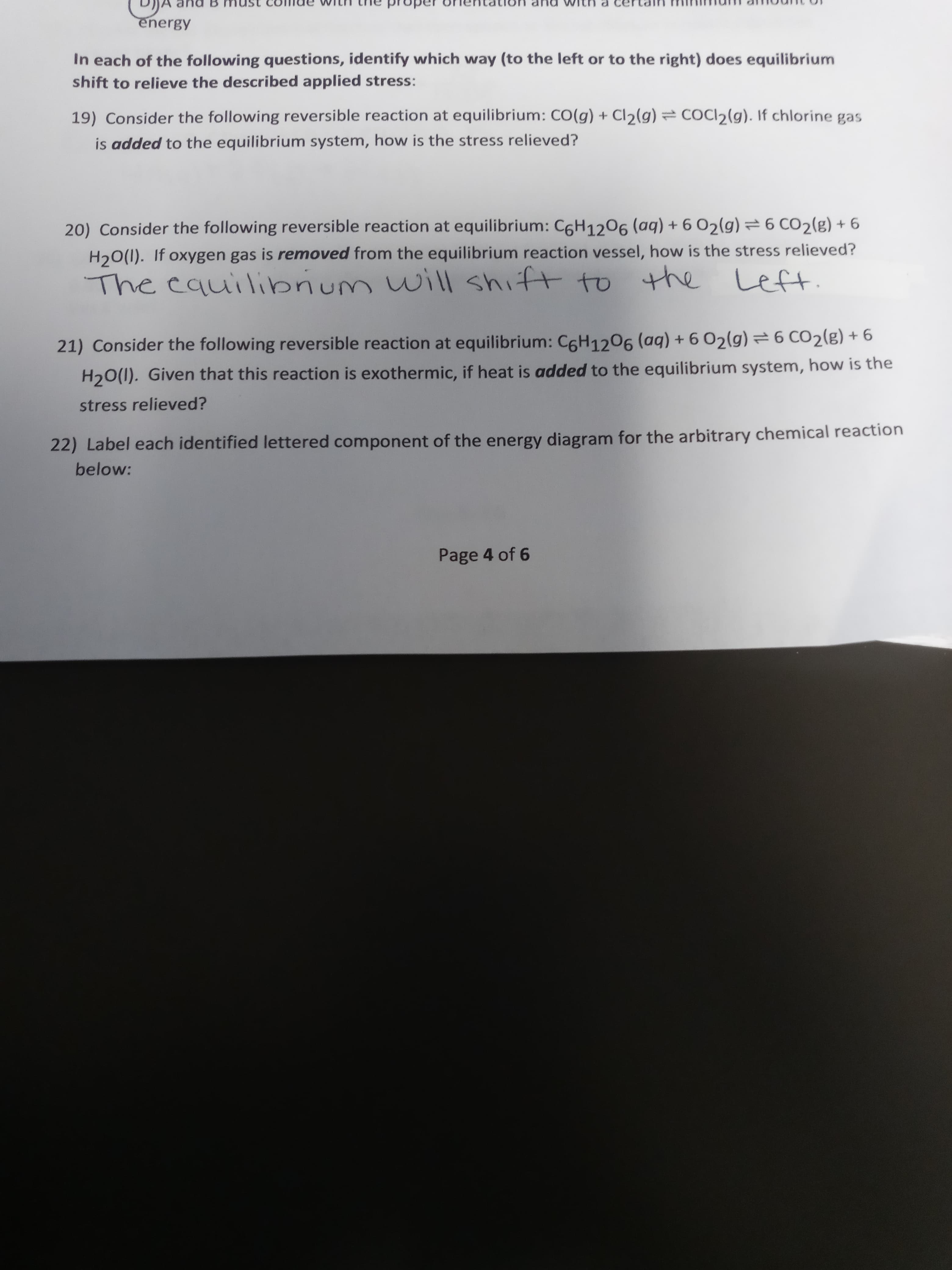an energy In each of the following questions, identify which way (to the left or to the right) does equilibrium shift to relieve the described applied stress: 19) Consider the following reversible reaction at equilibrium: CO(g) + Cl2(g) = COCI2(g). If chlorine gas is added to the equilibrium system, how is the stress relieved? 20) Consider the following reversible reaction at equilibrium: C6H1206(aq)+602(g) =6 CO2(g) + 6 H20(1). If oxygen gas is removed from the equilibrium reaction vessel, how is the stress relieved? The cauilibrium will shift to the Leftt. 21) Consider the following reversible reaction at equilibrium: C6H1206 (aq) + 6 02(g) =6 CO2(g) + 6 H20(1). Given that this reaction is exothermic, if heat is added to the equilibrium system, how is the stress relieved? tion
an energy In each of the following questions, identify which way (to the left or to the right) does equilibrium shift to relieve the described applied stress: 19) Consider the following reversible reaction at equilibrium: CO(g) + Cl2(g) = COCI2(g). If chlorine gas is added to the equilibrium system, how is the stress relieved? 20) Consider the following reversible reaction at equilibrium: C6H1206(aq)+602(g) =6 CO2(g) + 6 H20(1). If oxygen gas is removed from the equilibrium reaction vessel, how is the stress relieved? The cauilibrium will shift to the Leftt. 21) Consider the following reversible reaction at equilibrium: C6H1206 (aq) + 6 02(g) =6 CO2(g) + 6 H20(1). Given that this reaction is exothermic, if heat is added to the equilibrium system, how is the stress relieved? tion
Chemistry & Chemical Reactivity
10th Edition
ISBN:9781337399074
Author:John C. Kotz, Paul M. Treichel, John Townsend, David Treichel
Publisher:John C. Kotz, Paul M. Treichel, John Townsend, David Treichel
Chapter15: Principles Of Chemical Reactivity: Equilibria
Section: Chapter Questions
Problem 28PS: Kp for the following reaction is 0.16 at 25 C: 2 NOBr(g) 2 NO(g) + Br2(g) The enthalpy change for...
Related questions
Question
Question 21

Transcribed Image Text:an
energy
In each of the following questions, identify which way (to the left or to the right) does equilibrium
shift to relieve the described applied stress:
19) Consider the following reversible reaction at equilibrium: CO(g) + Cl2(g) = COCI2(g). If chlorine gas
is added to the equilibrium system, how is the stress relieved?
20) Consider the following reversible reaction at equilibrium: C6H1206(aq)+602(g) =6 CO2(g) + 6
H20(1). If oxygen gas is removed from the equilibrium reaction vessel, how is the stress relieved?
The cauilibrium will shift to the Leftt.
21) Consider the following reversible reaction at equilibrium: C6H1206 (aq) + 6 02(g) =6 CO2(g) + 6
H20(1). Given that this reaction is exothermic, if heat is added to the equilibrium system, how is the
stress relieved?
tion
Expert Solution
This question has been solved!
Explore an expertly crafted, step-by-step solution for a thorough understanding of key concepts.
This is a popular solution!
Trending now
This is a popular solution!
Step by step
Solved in 3 steps

Knowledge Booster
Learn more about
Need a deep-dive on the concept behind this application? Look no further. Learn more about this topic, chemistry and related others by exploring similar questions and additional content below.Recommended textbooks for you

Chemistry & Chemical Reactivity
Chemistry
ISBN:
9781337399074
Author:
John C. Kotz, Paul M. Treichel, John Townsend, David Treichel
Publisher:
Cengage Learning

Chemistry & Chemical Reactivity
Chemistry
ISBN:
9781133949640
Author:
John C. Kotz, Paul M. Treichel, John Townsend, David Treichel
Publisher:
Cengage Learning


Chemistry & Chemical Reactivity
Chemistry
ISBN:
9781337399074
Author:
John C. Kotz, Paul M. Treichel, John Townsend, David Treichel
Publisher:
Cengage Learning

Chemistry & Chemical Reactivity
Chemistry
ISBN:
9781133949640
Author:
John C. Kotz, Paul M. Treichel, John Townsend, David Treichel
Publisher:
Cengage Learning


Chemistry
Chemistry
ISBN:
9781305957404
Author:
Steven S. Zumdahl, Susan A. Zumdahl, Donald J. DeCoste
Publisher:
Cengage Learning

Chemistry: An Atoms First Approach
Chemistry
ISBN:
9781305079243
Author:
Steven S. Zumdahl, Susan A. Zumdahl
Publisher:
Cengage Learning

Chemistry for Engineering Students
Chemistry
ISBN:
9781337398909
Author:
Lawrence S. Brown, Tom Holme
Publisher:
Cengage Learning